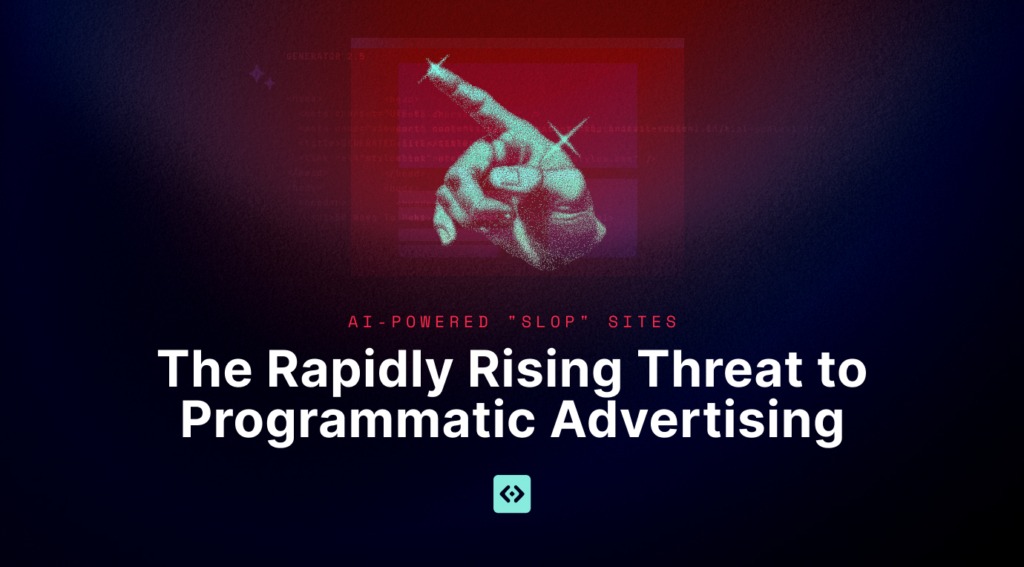
If you’ve ever browsed the web and landed on a site that felt suspiciously vague, repetitive, or just plain low-quality, you’ve probably encountered what’s known as a ‘slop‘ site. Once the domain of content farms, these low-quality websites are now being mass-produced by generative AI at unprecedented speed. While they may look harmless at first glance, their impact on programmatic advertising is anything but.
A 717% Surge in AI-Generated ‘MFA‘ Sites
Over the past 12 months, we’ve observed a staggering 717% increase in the creation of AI-generated template sites. These are web pages specifically crafted to maximize ad revenue while providing minimal or no genuine content value. Our latest data shows our list ballooned from approximately 17K suspicious domains in mid-2024 to over 108K by May 2025. Of these, around 97K have been flagged specifically as AI-driven content mills.
This explosive growth can be traced directly to the commodification and accessibility of generative AI tools like OpenAI’s GPT models, Google’s Gemini, and numerous open-source alternatives. It’s easier than ever to mass-produce content – and monetize it through programmatic platforms. Such AI tools allow fraudsters and low-quality publishers to churn out thousands of pages rapidly and cheaply, drastically lowering the barrier to entry for creating MFA inventory.
The ephemeral nature of these “slop” sites is a key characteristic. Of the sites we’ve flagged, 53% were registered recently. For template sites with a recent registration signal, it was on average 54 days from registration to ads appearing, with many appearing much faster and some lasting longer. What’s more, about 78% of the AI “slop” we’ve ever flagged is now defunct. Once these sites hit the bidstream, the majority of the available ad impressions they will ever generate occur within the first 60 days. This rapid churn primarily impacts buyers who do not utilize target lists for their campaigns.
The Cost to Advertisers: Budget Waste, Bad Metrics, and Brand Risk
AI-generated MFA sites represent a multi-layered threat to advertisers:
- Wasted Spend: Advertisers unknowingly pay for impressions that are largely meaningless, interacting with content that rarely engages actual, valuable audiences.
- Skewed KPIs: Ad placements on these AI-generated pages skew performance metrics, clicks, views, and engagement metrics are artificially inflated, misleading marketers about campaign effectiveness and distorting key KPIs.
- Brand Safety Concerns: AI-generated sites often feature nonsensical or inappropriate content, constructed algorithmically without human oversight. Sites have the potential to contain offensive auto-generated material, risking brand adjacency nightmares.
Legitimate Publishers Get Squeezed
The collateral damage doesn’t stop at buyers – it also deeply affects legitimate publishers who are working diligently to produce quality content and maintain transparent practices. With increasing volumes of junk inventory cluttering the ad marketplace, reputable publishers find themselves competing unfairly for ad dollars. Programmatic algorithms, stretched thin by waves of low-quality supply, can struggle to distinguish good from bad, inadvertently driving down CPMs and revenue potential for publishers genuinely contributing value to the open web.
At DeepSee.io, we classify these problematic sites specifically under our Template Site category- part of our broader ACT (Arbitrage, Clutter, Template) classification framework. We classify these AI content farms primarily under the Template Site label: sites with reused layouts, generic content, and signals like fake author attribution, or inorganic author profiles. Read more in our blog post on tackling template sites.
Our updated MFA definitions clarify these standards further, helping advertisers better understand and recognize MFA threats and empowering high-quality publishers to stand out in a crowded digital landscape.
By proactively identifying and filtering out AI-driven MFA inventory, we can restore advertiser trust and direct more revenue toward publishers who truly invest in quality content creation and responsible ad practices.
What Can Advertisers Do to Mitigate This Threat?
Major SSPs and DSPs are openly struggling to keep pace with the volume and sophistication of slop sites flooding the open web. Platforms like Equativ have started blacklisting MFA domains at scale – a promising sign that industry responses are beginning to catch up.
But solving this problem requires more than blunt-force domain suppression. Staying ahead of AI-generated junk demands ongoing efforts:
- Vet inventory regularly, using dynamic, signal-driven intelligence – not static lists.
- Maintain and audit blocklists and inclusion lists.
- Review campaign results through a quality lens, not just performance metrics.
We work closely with buyers and platforms to support better inventory hygiene – from identifying risk signals to auditing domain lists for quality and compliance. If you’re unsure how much low-quality or AI-generated inventory might be making its way into your campaigns or inventory, we offer a free audit to help you assess where things stand. Get in touch with our team to find out more.
The Road Ahead: Future-Proofing Against AI-Generated ‘Slop‘ Sites
Generative AI will only get faster, cheaper, and more sophisticated. But so will the tools used to detect, classify, and disarm the junk inventory it powers.
At DeepSee.io, we’re continuously evolving our detection models, expanding our datasets, and refining our approach to quality and risk signals. As part of our ongoing efforts, we are making significant updates to our Template detection process and definition, and are also developing a new AI image classifier to further enhance our capabilities. These upcoming releases will provide even more robust tools for identifying and mitigating AI-generated “slop.”
There’s no silver bullet – but there is a path forward. Through transparency, technology, and a focus on quality, we can protect ad dollars and reward the publishers who actually deserve them. We are committed to making this article a dynamic resource, and will be adding links to new posts we publish on these topics to ensure it remains a comprehensive guide for the industry.








